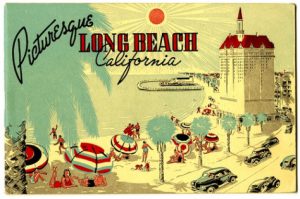
More often than not our work in genealogy and family history leads us to more than one proverbial brick wall. No matter how hard we try, or with what tenacity we might pursue that much needed fact, vital record, or even secondary source material, it all seems to no avail. While there is no panacea to cover all the brick walls we encounter, there just might be a way to refocus attention on the task at hand, i.e., research, by looking at unrelated people, places, or things – in a familiar place.
We all love the genealogical treasures we find at the end of our searches, yet it is the thrill of the hunt that often keeps us going. My suggestion: search around common walls instead of brick walls. Sometimes we can find common walls that are simply items that pique our interest. Researching common walls might help us to improve our techniques, and provide a much needed analgesic for some of our own personal genealogical headaches.
I discovered a common wall of my own as I began to notice the geographical history surrounding Rebecca Jane “Jennie” Eggleston Jackson Waterman (1856–1937), through the posts on Vita Brevis by her great-great-grandson Scott C. Steward.[i] Scott writes that Jennie resided during the latter part of her life in Long Beach, California. He writes about Jennie’s only daughter, his great-grandmother Minnie Estelle Jackson Bell (1876–1935), and speculates about the curious family dynamic between his great-grandmother Bell and her siblings – five brothers.
I became curious about Jennie, and at first glance I wondered if I shared any common ancestry with her (none that I know of). This curiosity was an easy transition for me, as I was born in Long Beach myself, so already I had started to approach a common wall between Scott’s Jennie and myself.
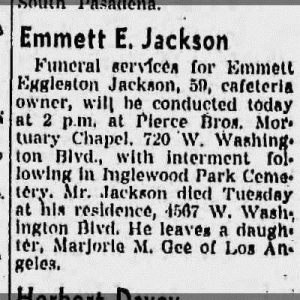
So what could I bring to the table here? What could this common Long Beach wall between Jennie Waterman and me possibly yield? Scott had indicated that he studied Jennie’s five sons with scattered success. There was one thing, though, that Scott had mentioned that stuck with me. Scott had stated once that his maternal grandfather Frederick Jackson Bell (1903–1994) had had only one first cousin, a Marjorie M. Gee named in the obituary of her father (Jennie’s son), Emmett Eggleston Jackson. Something about that interested me. As I read the obituary I couldn’t help but feel like there might be something here, or at least more to the story.
I began to question the name Marjorie M. Gee. It didn’t ‘feel’ right. I wondered at the surname of “Gee,” and about that particular surname in the year 1944. It would have most likely been Marjorie’s married name. Researching the name “Gee” showed that the name was not unknown in the area, but also that wasn’t extremely common. I could not find any record of a “Marjorie M. Gee” living in Los Angeles in mid-1944, or of a Marjorie M. Gee whose maiden name had ever been “Marjorie M. Jackson.”
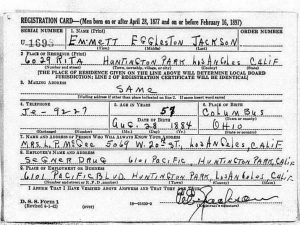
So I started to look back through the records for Jennie’s son, and Marjorie’s father, Emmett E. Jackson. I remembered from census records that Emmett’s wife’s name was Gladys (sometimes enumerated as “Lydie”).[ii] Almost by chance, I looked at Emmett’s World War II Draft Registration card, where it lists the “name and address of person who will always know your address.” It didn’t say “Gladys Jackson” or “Mrs. E. E. Jackson.” No, what appeared on that line was “Mrs. L. P. McGee.”
Whoever this was couldn’t be Emmett’s wife, and by 1942 both his mother Jennie Waterman and his sister Estelle Bell were deceased. This left two basic choices for who Mrs. L. P. McGee might be, either a close friend or some other next of kin, e.g. perhaps his daughter? If so, it would then follow that Mrs. L. P. McGee and Marjorie M. Jackson might necessarily be the same person – and, further, that Emmett’s obituary might hold a time-specific clue in the way the name McGee was recorded in 1944.
Next, I set about trying to see how this might be possible. I wanted to see if there was a Marjorie Jackson who married anyone resembling an “L. P. McGee” during the time frame of about 1929 (an estimated time when Marjorie would have been old enough to marry) through 1942 – the year of the draft card for her father. I had no luck.
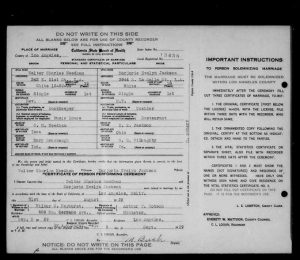
The only thing I could find that even resembled what I was looking for was the marriage of a Marjorie Evelyn Jackson to a Walter Charles Needham. This marriage took place on 31 August 1929 in Los Angeles County, with the marriage license indicating that this “Marjorie” was 18 years old and born in New York. While I hadn’t any New York State birth record for Marjorie Jackson, this information did match what had been reported about her in the census records. Fortunately, the application portion for the marriage listed the names of her father and mother, “E. E. Jackson and G. E. Willoughby.” I began to wonder if I wasn’t getting somewhere with this.
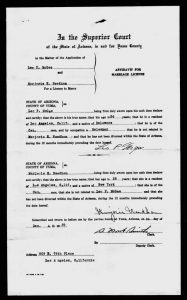
The next step was to see if it was possible that “Marjorie Evelyn Jackson Needham” might be one and the same person as “Marjorie M. Gee,” or as I was coming to see her, as “Mrs. L. P. McGee.” A review of Arizona marriage records indicated that on 24 December 1939 in Yuma County, one “Marjorie E. Needham” had married a “Leo P. McGee.” This showed with reasonably certainty that Emmett Eggleston Jackson’s daughter Marjorie was, in 1942, indeed “Mrs. L. P. McGee.” A marriage index search for the 1908 New Jersey marriage of Emmett Jackson and Gladys Willoughby confirmed the names of parents on the marriage record for Marjorie Jackson Needham. [iii]
So the next question is, “What became Jennie’s granddaughter Marjorie, the only known maternal first cousin of Scott Steward’s maternal grandfather Frederick Jackson Bell”? Did this branch of Jennie’s family leave behind any descendants?
The California Death Index and the U.S, Social Security Death Index list a death for a Marjorie Jackson McGee, born 21 March 1911, with a variation in the place of birth (California, with a pre-1951 Social Security number issued in New York), who died in Watsonville, Santa Cruz County, California on 18 March 1981. Marjorie’s mother’s maiden name is not listed on this record.
However, almost concurrently listed is the death of Leo Peter McGee, born 1 September 1906 in Delaware, who died in Watsonville 13 December 1980. It is likely that the informant who completed the death certificate for Marjorie simply did not know Marjorie’s mother’s maiden name. In the absence of death certificates, but given the location and time frame of these two deaths, it is reasonable to conclude that “Marjorie M. Gee” is the same person as “Mrs. L. P. McGee,” and is the same “Marjorie” who died in Santa Cruz County in 1981.
Sometimes it just pays to stop staring at your own brick walls for awhile, and to perhaps check out some of those walls you might share in common along the way.
Notes
[i] Scott C. Steward, “Some Recent Discoveries,” Vita Brevis, 15 July 2014; “ICYMI: Family Plots: Part Two,” Vita Brevis, 19 October 2015; “Lucky Clues,” Vita Brevis, 13 December 2016.
[ii] U.S. Federal Census Records 1920, Phoenix, Maricopa County, Arizona Household of Emmett Jackson.
[iii] New Jersey, Marriage Index, 1901-1914, Ancestry.com.
Great work Jeff!
These are the great stories that keep us in the hunt! I have a hand full of them myself -gathered in the process of casting a very wide net. A couple of them came about while trying to prove a theory I had about relationships of some families living close to each other. Another was a result of trying to disprove a questionable family story.
My two brick walls were born in 1810. How can I tailor my search to an earlier time such as early 1800s?
I’m in the same boat. My brick wall is in the NW Territory before it became Ohio. I had little to go on except my 3x great grandfather’s name, his approx. date and place of birth. The first thing I did was exhaust what I knew about him, his friends and family and possible siblings by combing through every census page by page. Once I had a clear idea of possible players, I found some land documents on ancestry.com that helped me narrow my search to two areas. I found the genealogical society for one place and learned they had discovered an 1807 Ohio Census; 4 years after Ohio became a state. Since the first US Census, except for Washington County, was in 1820 and the birth date was 1805, I was in luck. On that census I found three names, one of which could be my 3x great grandfather and the other his siblings.My next step was to look at the Territorial Papers of the United States of America. I got lucky there, too, and found the same people holding land in that area. The next step will be to learn more about these 3 men and see if I can connect them to my 3x great grandfather who ended up in Indiana. I am slowly uncovering what may look like my family, and if not, I am uncovering who is not my family.
Did you get the Social Security application she completed that might give her mothe’s maiden name? It is a bit of money if you don’t really need it. I find collaterals to be very helpful many times – especially those with odd first names like Redwood or Chew or Varvaser.
Great idea Sara! – I like your line of thought here.
Great Detective work and logic Jeff. Thank you for sharing and thank you for honoring this search with you God Given TIME!
Super sleuthing! I thought I had a hint for you as my ggrandparents Dominique(Dominick) Gouy and wife Mary Argust Gouy disappeared in the 1900 Census.
Found them listed with last name “Gee” a phonetic spelling from the census taker lusting to an Alsatian immigrant.
Just to add a level of trouble – they were all listed as the surname “Dominic”!!
For a long time I ignored brothers, sisters and employers of ancestors for whom I had a birth date guesstimate, and the same for death i.e. c. 1847. However, if a sibling does well in the world, the newspaper articles and obits offer quite a bit of family history, and the gracious boss praises his employees. I do like the use of gut feeling-could it possible be that?, that Jeff uses. Thank you for the story.
Chistena – it sounds like you and I are on the same path! It’s my experience that you can’t go wrong with following your instincts and seeing where it takes your research.
Great job cousin Jeff!!!!
What first caught my eye about your post, Jeff, was the wonderful graphic, showing Long Beach as a resort town. I have a great grandfather and a great aunt with connections there. In May, 1915, the great aunt, who was a trained nurse, was living in Wilkin Co, Minnesota with several relatives, including her father. She happened at the time to be visiting my grandparents and their three children in the tiny town of Assinaboia, Sask. Coincidentally, my grandmother was about eight months pregnant, and planned to return with her sister to her old home for the baby’s birth. At least there were doctors there, and her mother and other relatives to help out. The baby came early, and was tiny. She was my mother. May isn’t spring on the Canadian prairie, and lacking a NICU, or any kind of hospital, they put my mother in a shoebox and kept her warm on the open oven door. When spring did come, the sisters took the train to their parents’ home.
The following spring, 1916, my great aunt and her father moved to Long Beach. My common wall was “Why did they move to California? And why Long Beach?” I started hunting in two directions. At that time, Long Beach was a resort town. It was also well known as a place that people went especially for their health. This was before Arizona and New Mexico were *the* place to be, unless you were from the East and had money. My family didn’t. The other place I looked was at my g grandfather’s death certificate. He died of a long standing heart valve problem. I’m still not sure I’ve got the complete answer. But Minnesota was, and is, a place where people die from shoveling snow. There’s very little snow to shovel in Long Beach. According to my mother, who knew her grandfather, and the aunt who delivered her and took care of him in his old age, that was the story. When he died, the aunt stayed in Long Beach only a year or two. Then she married and moved to Seattle, where she already had two siblings. I remember her, her husband, and the daughter they adopted.
Do I have the story right? Where else might I look?
Doris
Seattle
A little off-topic, but had to comment on the shoebox-in-the-oven incubator story. I have the same story in my family of a barely 4-pound baby in New Brunswick. And have heard nearly a dozen similar stories over 50 years of family history work. Must have been quite a common procedure, but I’ve never seen it mentioned in books.
I think that the best genealogists are just naturally curious people, bittn by the thrill of the chase. I cannot count the time when I have gone down a rabbit hole, spending time trying to puzzle out the facts and circunstances of people who are not related to me. Usually, I learn a little something – and I have entertained myself!